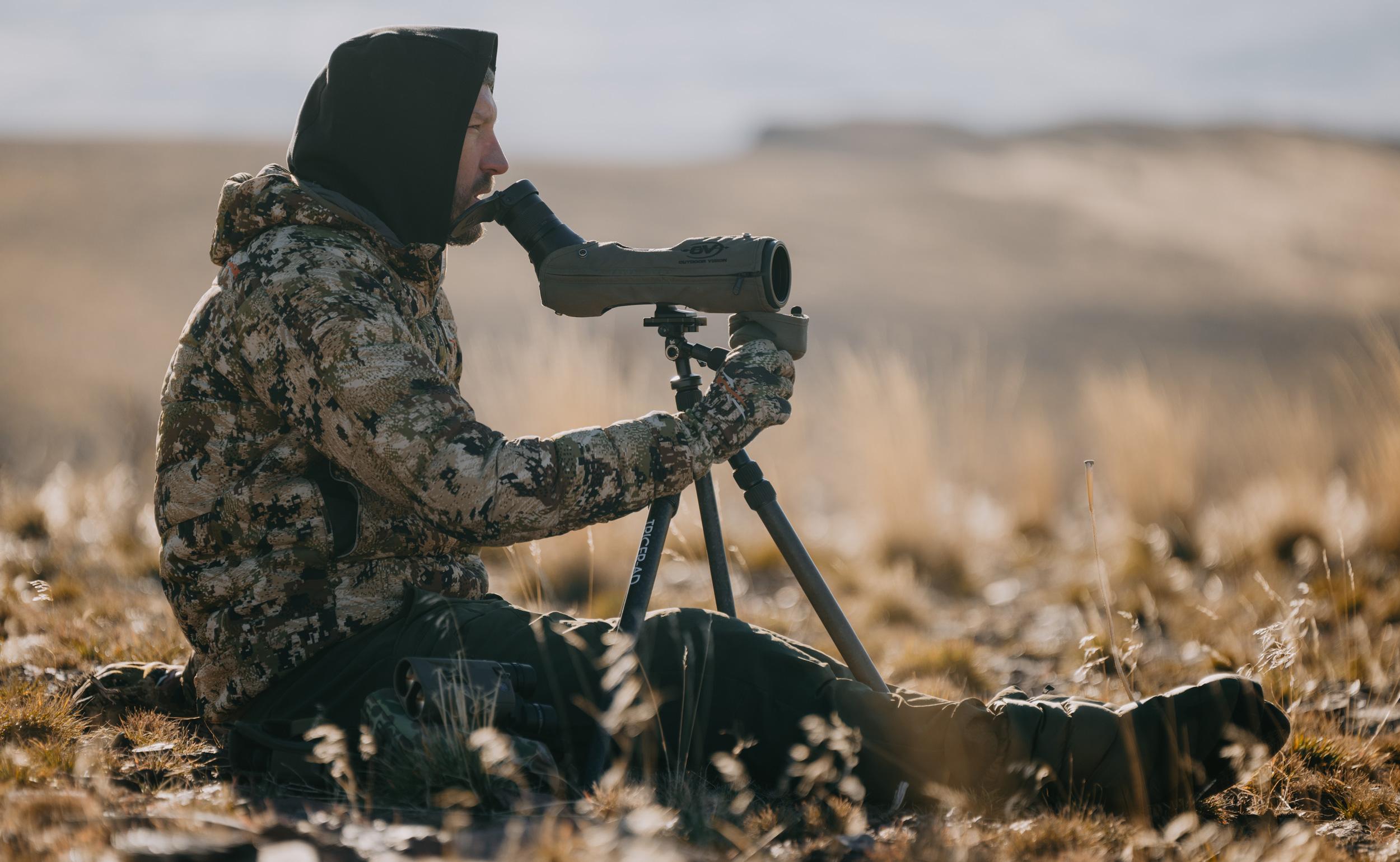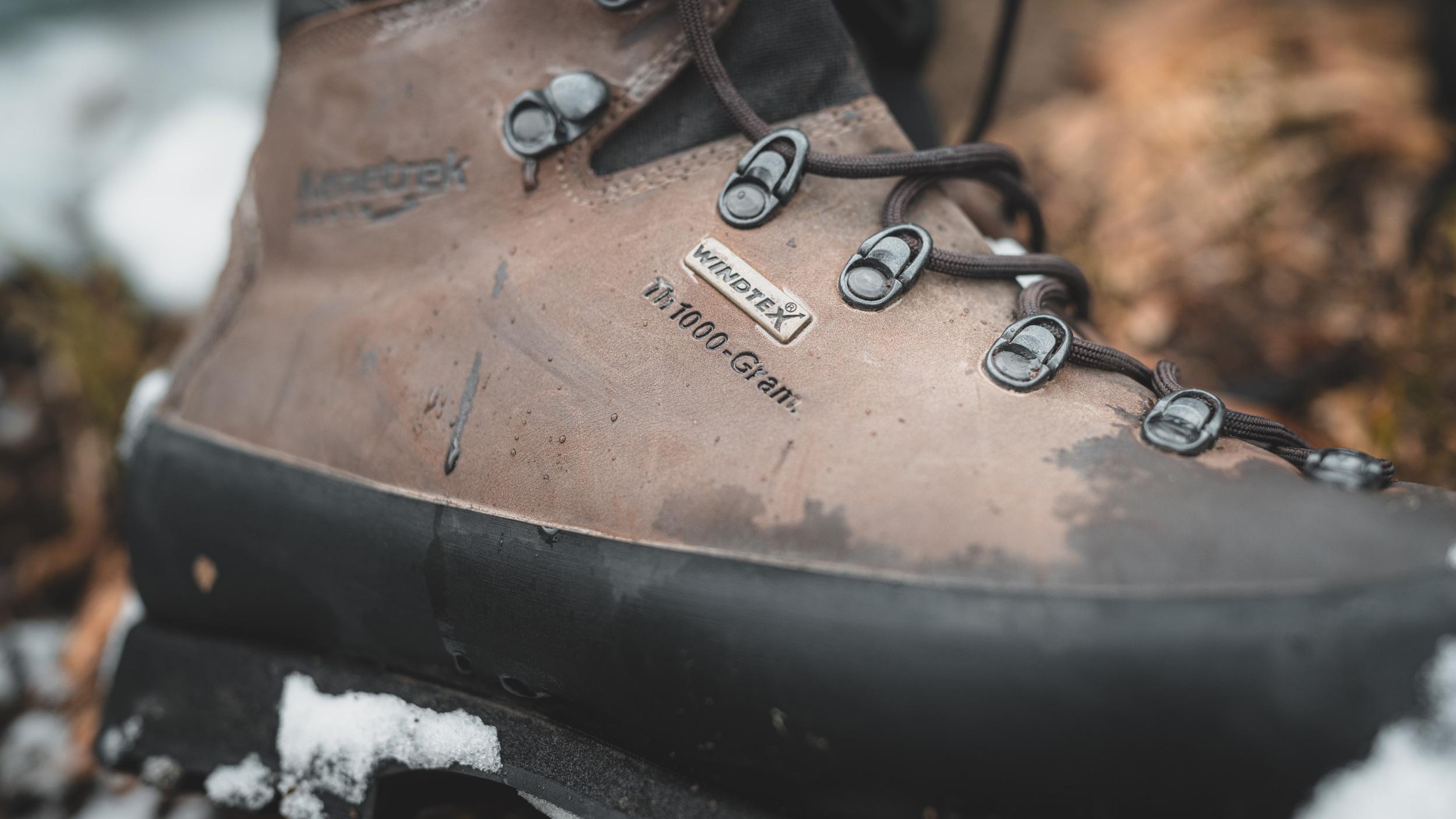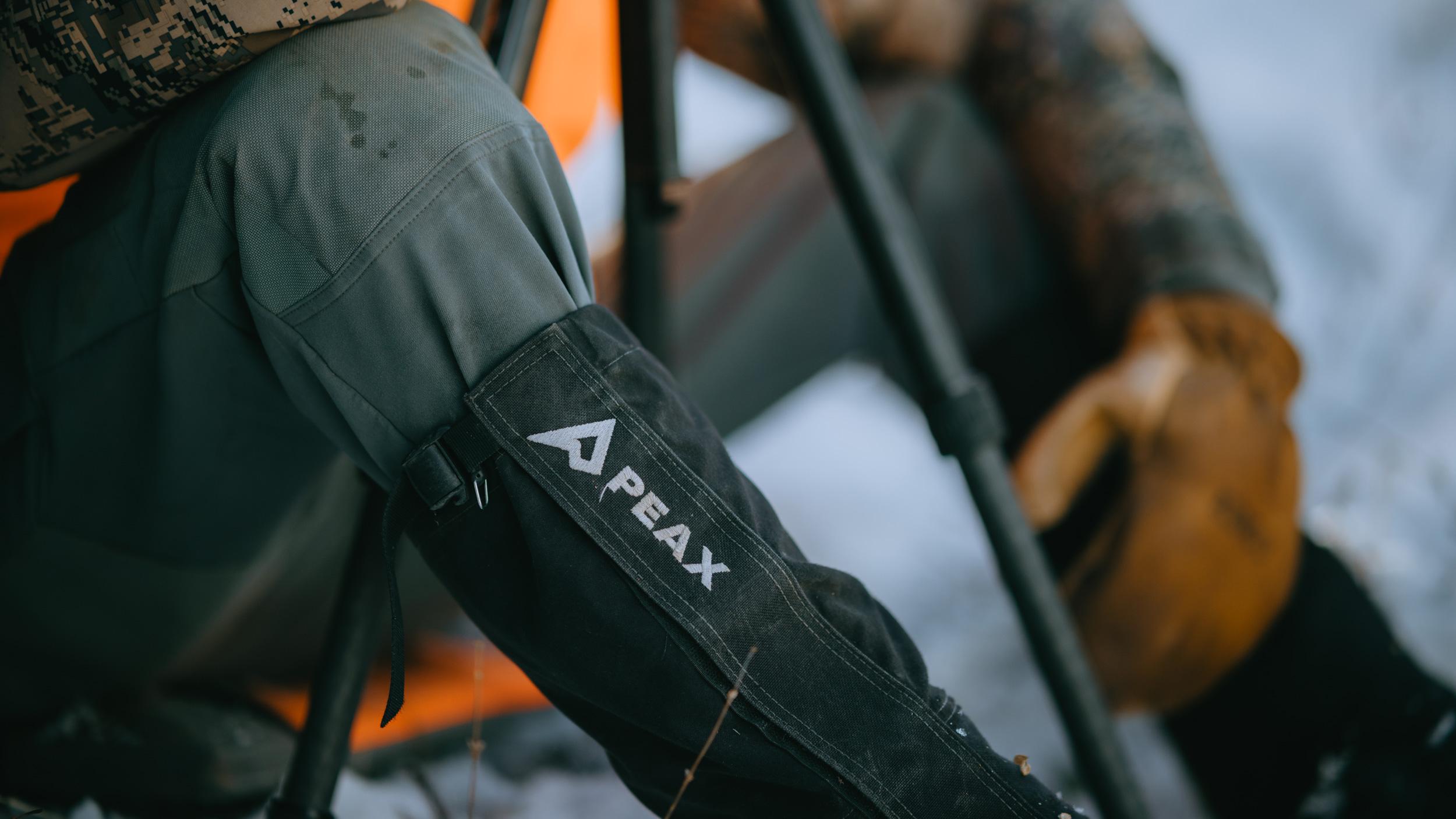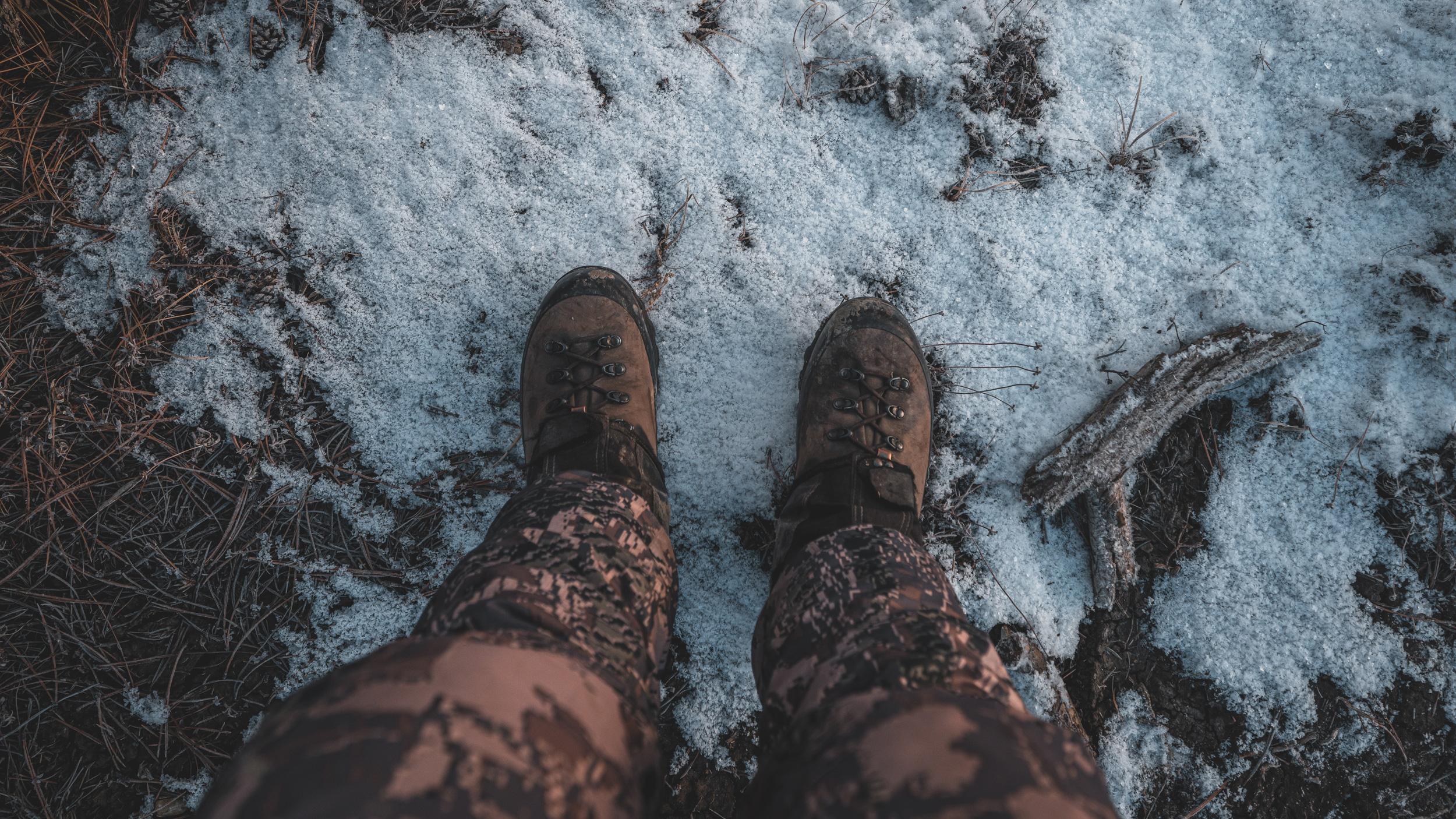




Trail Kreitzer wearing his lightweight insulated booties while glassing.

Kenetrek Mountain Extreme 1000-gram insulated leather boots.

Peax Storm Castle Gaiters on late season mule deer hunt.
Model |
Price |
Insulation |
Height |
Stiffness Scale |
Crispi Briksdal MTN |
$440 |
Uninsulated |
9" |
3.5 |
Crispi Briksdal Pro |
$520 |
200 gram |
10" |
4 |
Crispi Guide GTX |
$505 |
200 gram |
10" |
3 |
Hanwag Kalixfors SF Extra GTX |
$400 |
Uninsulated |
10” |
3 |
Lowa Tibet Evo GTX |
$455 |
Uninsulated |
8” |
4 |
Lowa Tibet Evo 400 GTX |
$520 |
400 gram |
8” |
4 |
Hanwag Alaska GTX |
$380 |
Uninsulated |
8” |
4 |
Kenetrek Mountain Extreme 400 |
$539.95 |
400 gram |
10” |
4 |
Kenetrek 10" Grizzly Pac Boot |
$294.95 |
Removable 6 mm Liner |
10" |
2.5 |
Kenetrek Mountain Guide 400 |
$554.95 |
400 gram |
10" |
4 |
Hanwag Trapper Top GTX |
$490 |
Insulated |
10” |
4 |
White's Lochsa Grande Ronde Series Insulated |
$420 |
400 gram |
8" |
3.5 |
Zamberlan 2092 Mountain Trek GTX RR |
$490 |
Uninsulated |
8” |
4.5 |
Zamberlan 1005 Hunter Pro Evo GTX RR WL |
$500 |
Insulated - rated to - 4 |
10” |
4 |
Zamberlan 980 Outfitter GTX RR |
$490 |
Uninsulated |
11” |
4 |
Lacrosse Men's Alpha Agility 1200G |
$189.95 |
1200 gram |
17" |
2 |
Lacrosse Men's Alphaburly Pro 800G |
$239.95 |
800 gram |
18" |
2 |
Model | Price | Insulation | Height | Stiffness Scale |
Crispi Briksdal MTN | $440 | Uninsulated | 9" | 3.5 |
Crispi Briksdal Pro | $520 | 200 gram | 10" | 4 |
Crispi Guide GTX | $505 | 200 gram | 10" | 3 |
Hanwag Kalixfors SF Extra GTX | $400 | Uninsulated | 10” | 3 |
Lowa Tibet Evo GTX | $455 | Uninsulated | 8” | 4 |
Lowa Tibet Evo 400 GTX | $520 | 400 gram | 8” | 4 |
Hanwag Alaska GTX | $380 | Uninsulated | 8” | 4 |
Kenetrek Mountain Extreme 400 | $539.95 | 400 gram | 10” | 4 |
Kenetrek 10" Grizzly Pac Boot | $294.95 | Removable 6 mm Liner | 10" | 2.5 |
Kenetrek Mountain Guide 400 | $554.95 | 400 gram | 10" | 4 |
Hanwag Trapper Top GTX | $490 | Insulated | 10” | 4 |
White's Lochsa Grande Ronde Series Insulated | $420 | 400 gram | 8" | 3.5 |
Zamberlan 2092 Mountain Trek GTX RR | $490 | Uninsulated | 8” | 4.5 |
Zamberlan 1005 Hunter Pro Evo GTX RR WL | $500 | Insulated - rated to - 4 | 10” | 4 |
Zamberlan 980 Outfitter GTX RR | $490 | Uninsulated | 11” | 4 |
Lacrosse Men's Alpha Agility 1200G | $189.95 | 1200 gram | 17" | 2 |
Lacrosse Men's Alphaburly Pro 800G | $239.95 | 800 gram | 18" | 2 |

Although it’s been unseasonably warm across the West, late-season hunts are quickly approaching, and whether you are in need of new boots for this fall or are considering buying and breaking in a pair for spring shed hunting, now is a good time to buy some new boots. Similar to most things in life, there are few one-size-fits-all options, and you’ll likely need a pair of boots that are better suited for late-season hunting. Let’s discuss some characteristics of what makes a good late-season hunting boot, and then I’ll list some of the options I think are a good fit for this time of year.
Late-season hunting in rough terrain has its own set of unique challenges. The first is that the weather is cold and can be wet so you’ll likely need a boot that offers some insulation and is also waterproof. Second, elk and deer hunting terrain doesn’t get any easier to navigate, regardless of the season, so you’ll need a boot that has good grip, adequate tread, and is stiff enough that it offers support to your feet, legs, and weight when carrying a heavy pack. Lastly, the boot will need to be comfortable or, at a minimum, it should not cause any numbness, hot spots or blistering. Finding a boot that offers you all of these characteristics is key.
One of the most common questions we get in the GOHUNT Gear Shop is, “Should I buy insulated boots or uninsulated boots?”
Unfortunately, there isn’t a blanket statement that I can offer in regards to this question because so much of it depends on the individual, but I can offer some direction.
The first consideration or question I would ask in return is, “Do you run hot or cold?” And, by that, I mean how is your circulation? When the temperature gets below 40 degrees and you’re hiking or sitting to glass, have you noticed that your feet are colder than your hunting buddies? If they are cold, is it because your feet are wet from sweat and get cold during longer periods when you are stationary? If you have poorer circulation, if you tend to run cold or if you’re not hiking a lot and are doing more road hunting and glassing, then insulated boots are a good idea. If your feet tend to be okay while you’re hiking, and are wet out from the inside from sweat regardless of the temperature, then uninsulated boots are probably the better bet and you’ll need to find a way to deal with cold feet while you’re glassing.
Personally, I fall into the second category, so I lean towards uninsulated boots or lightly insulated boots for hiking, and I remove my boots and put on down booties while I’m glassing. I may even carry the small hand warmer packets to put inside the down booties for really cold temperatures.
Most boot manufacturers use Thinsulate in their insulated models, which is a synthetic fiber that insulates even when wet. Insulated boots are commonly available in 400 gram, 600 gram, and some are even higher. The 400 grams is a good option for cooler temperatures when you are less active or for an active hunter in cold temperatures. Moving into 600 and higher gram counts, those options are better for low to moderate activity level hunts in cold temperatures or for stationary hunts in cool temperatures if you tend to run cold. Once you get into 800 grams plus, these are better for very cold temperatures with some hiking or even treestand hunting.
It should be noted that along with this discussion, you should wear a pair of quality merino wool socks. Merino wool is naturally moisture-wicking and breathable, which helps pull moisture away from your feet and allows it to escape through your boots more easily. It’s also important to consider the thickness of the socks you’ll be wearing and size your boot accordingly. For late season hunting, I might suggest a full cushion sock like the Darn Tough 2013 Men's Over-the-Calf Heavyweight Hunting Sock or the Darn Tough 2012 Boot Full Cushion Midweight Hunting Sock. Also, consider that during cold late season hunts you’re probably going to choose a thicker sock and if you choose an insulated boot, you should size up slightly. If your boots are too tight, they’ll feel colder than they would otherwise.
Late-season hunts can be snowy, and even if snow is not in the forecast, it’s common to be dealing with creek and river crossings and heavy frost in the morning. A good late-season boot should be waterproof. Most boot manufacturers use a breathable waterproof layer like Gore-Tex or something similar. Your boots should be labeled as waterproof. In addition, I believe that a full leather upper with minimal seams is a better boot choice for late season hunts. Although a full leather boot is heavier than a synthetic or blended option, the full leather upper will be more waterproof and less likely to leak due to the fact that there are fewer points of potential failure. Full leather boots are also more durable and can be waterproofed further by applying an exterior waterproofing wax.
To conclude, before moving into other considerations like stiffness/support and boot height, I suggest you think about the temperature, the activity level of the hunt you are going on, and whether you run hot or cold. A 400 gram insulated boot is a good middle-of-the-road option for most late season western hunts. Buy quality merino full cushion socks. A full leather, waterproof boot is a better option for mid to late seasons. Finally, make sure when you buy boots that you consider the thickness of the sock, how insulated they are and, in most cases, choosing a half size larger is a better bet.
The sole stiffness, or flexibility of a boot, is going to fall within a range of soft and flexible to rigid and stiff. Our gear shop developed a stiffness scale that ranges from 1 to 5 with the lower levels being very flexible for fast and light hiking. Learn more about GOHUNT's Boot Stiffness Scale below:
For late-season deer and elk hunts, I suggest that most people should consider boots that fall within the 3 and 4-scale. Flex 3 is ideally suited for mountain hunts with moderate to steep technical terrain where more rigidity is required. Some break-in time may be required. Flex 4 is best suited for hunts at or above timberline where the terrain gets steep. This level is flexible enough that it can handle miles of comfortable climbing, but it’s still stiff enough to offer support and rigidity with a heavy pack. Late season mountain hunts often require a bit more rigidity in my opinion due to the wet conditions and needed stability. A stiffer sole and a more rigid upper will help reduce leg fatigue when you’re carrying a heavy pack. In addition to the stiffness of the sole, I believe the depth of the tread and the rubber is worth considering. Deeper lugs on the boot tread will offer much better traction in wet, snowy conditions. The rubber used in the sole can also offer pros and cons. A softer rubber will be better on wet rocks and vegetation, but it’s less durable and wears out over time. A denser, stiffer rubber sole will give you better longevity, but can be more slick on wet, rocky surfaces.
Stiffer boots may require a break-in period before they actually feel comfortable enough to take on a hunt. However, once they’re broken in, they can be some of the most comfortable boots you wear. On the other hand, more flexible boots are usually comfortable right out of the box and don’t require as much of a break-in period, if any, compared to stiffer boots. You’ll also have fewer chances of hot spots or blisters. If you’re short on time, I would urge you toward boots in the level 3 scale in our gear shop stiffness range. If you have a little time to break them in, the level 4 is going to be a good boot for late season hunting.
What’s the best boot height for you? Before answering, I would first suggest you pair whatever boots you choose with a waterproof calf height gaiter. A gaiter will keep snow out of your boots, add some insulation and keep you drier and warmer overall. My favorite gaiters are the Stone Glacier SQ2 Alpine Gaiter, PEAX Storm Castle Gaiters and the SITKA Stormfront Gaiters.
For late-season hunts, I would recommend either 8” or 10” tall boots. A 10” boot can be uncomfortable for some if they’re not properly broken in due to calf pinch on the descent. Personally, I like a 8” to 9” boot for all hunting and that height would be my recommendation.
If you're looking directly for insulated boots, jump to the link below:
Best of luck in your search for the perfect late-season hunting boot. If you have any questions, we'd be happy to help. You can drop us a comment below or send us an email at reachus@gohunt.com